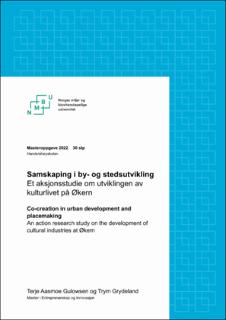| dc.contributor.advisor | Kubberød, Elin | |
| dc.contributor.author | Grydeland, Trym | |
| dc.contributor.author | Gulowsen, Terje Aasmoe | |
| dc.coverage.spatial | Norway, Oslo, Økern | en_US |
| dc.date.accessioned | 2022-09-22T08:50:36Z | |
| dc.date.available | 2022-09-22T08:50:36Z | |
| dc.date.issued | 2022 | |
| dc.identifier.uri | https://hdl.handle.net/11250/3020586 | |
| dc.description.abstract | Bakgrunn: Innovasjonsdistrikt Hovinbyen i Oslo er et stort byutviklingsprosjekt hvor det er anslått at det skal bo og jobbe 130 000 nye mennesker innen 2040. Økern vil ble Hovinbyen sitt sentrum, hvor det i dag planlegges store transformasjoner av området. Det foreligger flere gode initiativer hos de private og offentlige interessentene, men ingen samkjørt strategi for kultur på tvers av partene. Dermed er det interessant å undersøke om innovasjon- og systemmetodikk kan bidra til samskaping hos interessentene involvert, som igjen skal sikre at Økern blir et sted og en destinasjon med et rikt kultur- og byliv.
Hensikt: Hensikten med studien har vært å undersøke hvorvidt en kombinasjon av Design Thinking og systemtenking kan føre til mer samskaping og slik skape verdi for interessentene på Økern. Vi ønsket å se hvordan kombinasjonen bidro til innsikt på fagfeltet, samt utbytte og prosesser. For å besvare dette satte vi opp følgende problemstilling: Hvordan kan kjente innovasjonsmetoder og prinsipper bidra til mer samskaping i by- og stedsutvikling?
Metode: Oppgaven har benyttet aksjonsforskning som metodetilnærming for å besvare problemstillingen. Det er blitt gjennomført en kombinasjon av Design Thinking og systemtenking over fire faser. Det er anvendt kvalitative datainnsamlingsmetoder som dybdeintervju, observasjoner og workshops. Informantene i studien har alle erfaring med og arbeider direkte med by- og stedsutvikling. De har bakgrunn som private utviklere, private kulturaktører, offentlige etater, nettverksbyggere og kunstnere.
Funn og implikasjoner: Studien har bidratt med generering av kortsiktige og langsiktige kultur- og aktiviseringstiltak på Økern. Fokuset på brukerperspektiver i fase en og idemyldring i fase tre ga spesielt gode resultater, med hensyn til metodeutviklingen og utbytte. Prosessen ga klar indikasjon på at metoden anvendt bidro til bevisstgjøring av problemområdet for interessentene, samt fungerte godt som innovasjon- og samskapingsverktøy. Implementering av prosesser nødvendig for videre utbytte vil være ressurskrevende, men vi håper studien viser fordelene ved adoptering av innovasjonsmetoder i forretningsstrategien. | en_US |
| dc.description.abstract | Background: Innovation District Hovinbyen in Oslo is a large urban development project where a projected 130.000 inhabitants will work and live by 2040. Økern will be the center of the new district Hovinbyen, where there are extensive plans for transforming the area. Private developers and public institutions have both great initiatives, but there is no common strategy for development of cultural offerings between the two parties. It is therefore interesting to study if innovation- and system methodic can contribute to co-creation between them. This will further secure the plans of turning Økern into a place rich in cultural and city life.
Purpose: The purpose of the study was to survey if a combination of Design Thinking and system thinking could lead to more co-creation, and thereby create value for the involved parties at Økern. We wished to see how the combination between the two aforementioned theories contributed to further gain in the scientific field of interest concerning dividends and processes. To answer this question, we came up with the following research question: How can well known methods of innovation contribute to more co-creation in urban and location specific development?
Method: The study has used action research as an approach to answer the research question. A combination of Design Thinking and systems thinking have been deployed through a four-stage process. Qualitative data gathering techniques such as depth interviews, observations and workshops have been applied. The informants in this study all have experience with and are working with tasks connected to urban and location specific development. Their backgrounds are as private developers, cultural participants, public institutions, networking organizations and artists.
Findings and implications: The study has contributed by generating short- and long-term cultural and mobilizing measures at Økern. The focus on user perspectives in stage one and brainstorming in stage three gave especially great results, with regards to the development of the method. The process gave a clear indication that the method used contributed to increase the awareness of the problem at hand for the agents involved and worked well as an innovation- and co-creation tool. Implementation of further processes that are necessary for continued growth will be resource-intensive, but we hope the study will highlight the perks of adopting methods of innovation in business strategy. | en_US |
| dc.language.iso | nob | en_US |
| dc.publisher | Norwegian University of Life Science, Ås | en_US |
| dc.rights | Attribution-NonCommercial-NoDerivatives 4.0 Internasjonal | * |
| dc.rights.uri | http://creativecommons.org/licenses/by-nc-nd/4.0/deed.no | * |
| dc.title | Samskaping i by- og stedsutvikling : et aksjonsstudie om utviklingen av kulturlivet på Økern | en_US |
| dc.title.alternative | Co-creation in urban development and placemaking : an action research study on the development of cultural industries at Økern | en_US |
| dc.type | Master thesis | en_US |
| dc.description.localcode | M-EI | en_US |

